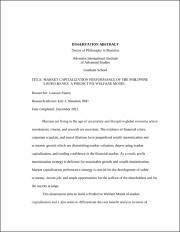| dc.description.abstract | Humans are living in the age of uncertainty and disruptive global economy where investments, returns, and rewards are uncertain. The evidence of financial crises, corporate scandals, and moral dilutions have jeopardized wealth maximization and economic growth which are diminishing market valuation, depreciating market capitalization, and eroding confidence in the financial market. As a result, profit maximization strategy is deficient for sustainable growth and wealth maximization. Market capitalization performance strategy is crucial for the development of stable economy, decent job, and ample opportunities for the welfare of the shareholders and for the society at large.
This dissertation aims to build a Predictive Welfare Model of market capitalization and it also seeks to differentiate the cost benefit analysis in terms of
net present value, internal rate of return, and profitability index according to bank characteristics. This study utilized descriptive-correlation design to determine the predictive power of independent variables and cost benefit analysis of banking resources to maximize market capitalization. Data were collected from 241 financial statements of 14 listed banks from 1993-2011.
The results showed that 7 variables (capital adequacy, asset quality, earning capacity, sensitivity, price earnings, dividend yield, and trading volume) have significantly predicted market capitalization, R2 = 0.469, R2 adj = 0.452, F(7, 214) = 27.030, and p = 0.000. As a result, the model contributed adjusted R2 45.2% variance of market capitalization. Therefore, the overall predictive market capitalization model, Y = 4.408+ -10.922(βC) + 2.068(βA) + -4.825(βS) + 0.489(βPE) +-9.233(βE) + 0.689(βST) + 4.435(βDY).
The findings of market capitalization performance model may be useful to banks‟ managers. The results also useful to shareholders for selection of potential shares, identification of company size, mergers and acquisitions, and valuation of banking firm. Further, the application of this model may help to generate maximize wealth for the shareholders and for the welfare of the society.
This study recommended the shareholders and bank portfolio managers to improve asset quality and reduce earning risk to maximize market capitalization. It also offered suggestions for future studies so that the body of knowledge related to market capitalization model may be expanded. These findings can be replicated in other countries particularly in the listed banks. | en_US |

